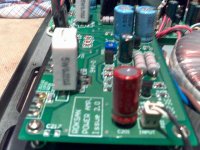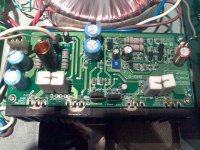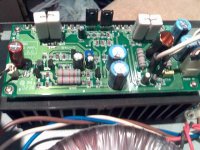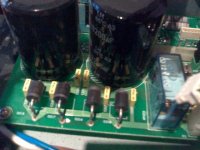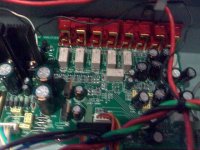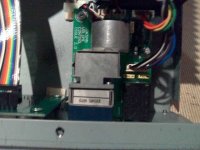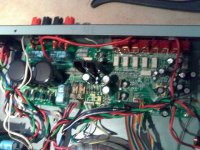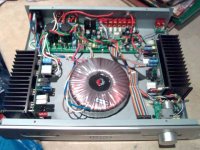Hi all. 
First post on the forum although i've been reading for a few months now.
What i'm looking to do is improve the sound of my Roksan Kandy mk3 amplifier, which i think is the weakest part of my system.
I do like the sound but feel its not revealing or detailed enough
If no-one here has tweaked one of these, any generic amp tweaks would be just as good.
I'm quite new to Diy electronics, although not too bad with a soldering iron.So far i've fitted better crossover components to my speakers and done a few mods to my cd player so hopefully i should be competent enough for this.
Any help would be appreciated.

First post on the forum although i've been reading for a few months now.
What i'm looking to do is improve the sound of my Roksan Kandy mk3 amplifier, which i think is the weakest part of my system.
I do like the sound but feel its not revealing or detailed enough
If no-one here has tweaked one of these, any generic amp tweaks would be just as good.
I'm quite new to Diy electronics, although not too bad with a soldering iron.So far i've fitted better crossover components to my speakers and done a few mods to my cd player so hopefully i should be competent enough for this.
Any help would be appreciated.
I don't know the Kandy that well, but to be honest, there isn't a lot you can do to an amp easily. Swapping PSU caps and possibly the input cap is the limit. You might be better off building something new from scratch. Have a look at the Symasym project, it's very accurate and detailed, and a pretty easy project to start.
If you do want to work on the Kandy, then you really need to track down a schematic.
If you do want to work on the Kandy, then you really need to track down a schematic.
Hi,
I agree with PM.
Changing the topology of the amp is not really an option so you'll just be swapping parts. The Kandy is quite an expensive piece of equipment so there may already be high quality components inside.
You should look at the volume pot and see what's already in there and replace if necessary.
Better quality or slightly bigger power supply caps may be an option but expensive. Take advice before even touching them.
Check out the thread on snubbers. That will keep you busy!!!
Diodes in the power supply could be looked at.
There is much debate over Schottky, fast recovery types at the moment. Generally accepted as good for preamps and C.D. players but not universally accepted as the best idea for power amps.
Changing resistors to high tolerance metal film is another option but I have heard that this can sometimes produce a harsh or more forward sound. Generally speaking though, high tolerance resistors are a good idea to obtain the best channel matching and therefore 'soundstage'. They may already be matched. ???
See what transistors are in there and get some advice on buying more of them and matching them yourself.
The bottom line: You need to find out which parts were made to sound good together (,'Voicing' the amplifier for a particular tone,) and which parts were restricted by cost.
A picture of the insides would be helpful.
These are just some suggestions to get you thinking. Some of the ideas are simple and some are a more advanced so proceed with caution and ask questions. This is for the sake of your amp and your LIFE!! Search out some threads on each topic and learn by others mistakes.
Alternatively ....... sell it and build your own!!!
Martin.
I agree with PM.
Changing the topology of the amp is not really an option so you'll just be swapping parts. The Kandy is quite an expensive piece of equipment so there may already be high quality components inside.
You should look at the volume pot and see what's already in there and replace if necessary.
Better quality or slightly bigger power supply caps may be an option but expensive. Take advice before even touching them.
Check out the thread on snubbers. That will keep you busy!!!
Diodes in the power supply could be looked at.
There is much debate over Schottky, fast recovery types at the moment. Generally accepted as good for preamps and C.D. players but not universally accepted as the best idea for power amps.
Changing resistors to high tolerance metal film is another option but I have heard that this can sometimes produce a harsh or more forward sound. Generally speaking though, high tolerance resistors are a good idea to obtain the best channel matching and therefore 'soundstage'. They may already be matched. ???
See what transistors are in there and get some advice on buying more of them and matching them yourself.
The bottom line: You need to find out which parts were made to sound good together (,'Voicing' the amplifier for a particular tone,) and which parts were restricted by cost.
A picture of the insides would be helpful.
These are just some suggestions to get you thinking. Some of the ideas are simple and some are a more advanced so proceed with caution and ask questions. This is for the sake of your amp and your LIFE!! Search out some threads on each topic and learn by others mistakes.
Alternatively ....... sell it and build your own!!!
Martin.
Cheers guys. Some good advice.
Ive been searching the web for any schematics or info on the amp but all i could find was for the latest 'L' version which has a different pcb layout and probably some other improvements.
Did see a few bits on the Kandy Cd player and it looks as though Roksan do use quality components in their equipment so it probably won't be worth replacing caps etc(think they use Panasonic fc's)as i won't get much improvement for the outlay.
Need to find out what resistors are used. Maybe replace with Vishays
I'll be looking at the volume pot although i suspect that'll be the same story. An ALPS blue could be an improvement.
Anyway,thanks for your suggestions.
I'll take some pics and post these soon.
Ive been searching the web for any schematics or info on the amp but all i could find was for the latest 'L' version which has a different pcb layout and probably some other improvements.
Did see a few bits on the Kandy Cd player and it looks as though Roksan do use quality components in their equipment so it probably won't be worth replacing caps etc(think they use Panasonic fc's)as i won't get much improvement for the outlay.
Need to find out what resistors are used. Maybe replace with Vishays
I'll be looking at the volume pot although i suspect that'll be the same story. An ALPS blue could be an improvement.
Anyway,thanks for your suggestions.
I'll take some pics and post these soon.
Apologies for the quality of pics. All taken and posted via mobile phone.
The amp looks and feels solid and well built with a solid chassis and a huge torroid.
The power amps are on seperate boards for each channel but the pre sits right next to the psu section.
All the sockets/terminals seem solid and good quality and the pot is an Alps(blue? The code on the side is ro295).
The bridge diodes are quite hefty and have HER 607 printed on them. Any use upgrading?
The voltage regs are the usual L7805,7812,7815 and 7915.i'll probably change these to LM317 etc at some stage.
My main issue with the amp is the caps.
Although there are 2 elna cerafines(one on each power amp module) the rest of the caps are 'teapo' manufactured.
A quick google has led me to believe that these aren't much cop, so these will be my first replacement.
I've seen some good diodes to try out after the caps, then i'll try the voltage regulators and see how far that takes me.
I didn't take a look at the output transistors as i don't have any heatsink compound to hand for the moment.
Any thoughts? The psu caps are 8200uf 80v and i was wondering if it was worth raising this to 10000uf?
Also, these are 12 caps in the pre section that don't have polarity markings. They are rated 100uf 16v and have 'pre 5n-a3 np' on the case.they are the same rating as the cerafines but are bigger.
Would these be bipolars?there still seems to be polarity markings on the board.
Thanks for reading.
The amp looks and feels solid and well built with a solid chassis and a huge torroid.
The power amps are on seperate boards for each channel but the pre sits right next to the psu section.
All the sockets/terminals seem solid and good quality and the pot is an Alps(blue? The code on the side is ro295).
The bridge diodes are quite hefty and have HER 607 printed on them. Any use upgrading?
The voltage regs are the usual L7805,7812,7815 and 7915.i'll probably change these to LM317 etc at some stage.
My main issue with the amp is the caps.
Although there are 2 elna cerafines(one on each power amp module) the rest of the caps are 'teapo' manufactured.
A quick google has led me to believe that these aren't much cop, so these will be my first replacement.
I've seen some good diodes to try out after the caps, then i'll try the voltage regulators and see how far that takes me.
I didn't take a look at the output transistors as i don't have any heatsink compound to hand for the moment.
Any thoughts? The psu caps are 8200uf 80v and i was wondering if it was worth raising this to 10000uf?
Also, these are 12 caps in the pre section that don't have polarity markings. They are rated 100uf 16v and have 'pre 5n-a3 np' on the case.they are the same rating as the cerafines but are bigger.
Would these be bipolars?there still seems to be polarity markings on the board.
Thanks for reading.
Sonusthree said:Changing resistors to high tolerance metal film is another option but I have heard that this can sometimes produce a harsh or more forward sound. Generally speaking though, high tolerance resistors are a good idea to obtain the best channel matching and therefore 'soundstage'. They may already be matched. ???
Metal film resistors are less noisy than typical carbon types. Using them in the low-level circuits of a power amplifier may yield a little noise improvement, but the significance is questionable. From a technical perspective, changing carbon resistors with metal film types in a power amplifier is as likely to produce a “harsh or more forward sound” as is painting the amplifier case yellow.
Also, a slight gain imbalance between stereo channels is entirely insignificant in contrast to room acoustics, unless of course, ones listening room is entirely acoustically symmetrical, the listeners head is fixed immobile equidistant from each loudspeaker during the listening experience and he/she has unusually equal hearing in both ears.
This isn’t the case for most people, and is what the “balance” control is usually used for.
Cheers,
Glen
seroxatmad said:maybe buying 1 soon but after a demo.
You may well be taking it home to keep
Seriously, they're good amps but after the success i had with improving my Marantz cd63ki(with a lot of help)i thought i'd give this a try.
Still haven't got round to it yet... been busy building my first subs.
seroxatmad said:
My amplifier a Cyrus 1 amplifier dont have any balance or tone controls.
Nor does the Kandy. I prefer it that way-keeps it simple.
- Status
- This old topic is closed. If you want to reopen this topic, contact a moderator using the "Report Post" button.
- Home
- Amplifiers
- Solid State
- Roksan Kandy mkIII Tweaks????

